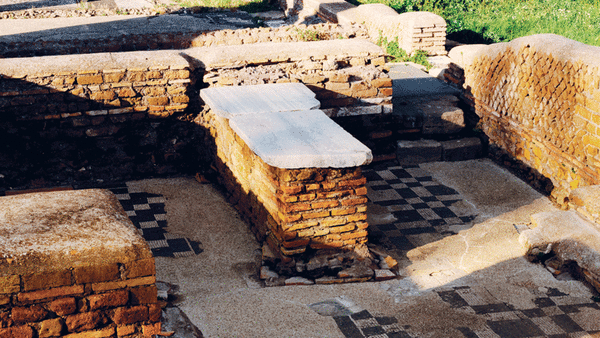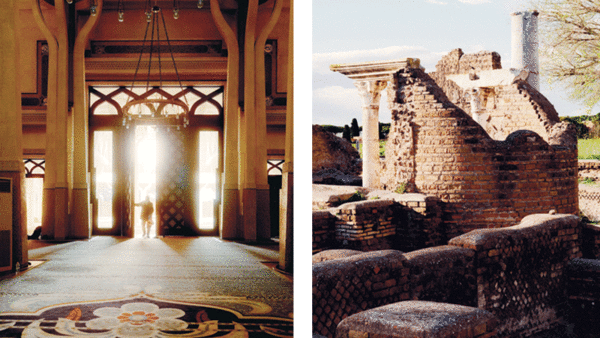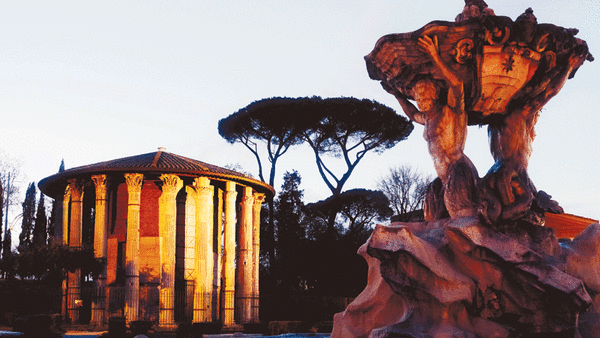

According to legend, Rome was born April 21, 753 BC, when Romulus, the survivor of its feuding twin founders, hitched his plow and furrowed a circular perimeter in the hills above the Tiber River. Everything inside was urbs, city space consecrated by priests who interpreted the will of the gods; everything outside was ager — unhallowed open territory. “We have a city founded by the auspices and augury,” Roman historian Livy wrote. “There is not a corner of it that is not full of our cults and our gods.”
Rome, in a sense, has been sacred ground right from the start.
To many, Rome is the epicentre of Catholicism, the seat of the Vatican and home to a seemingly infinite number of churches. But in the nearly three millenniums of the city’s recorded past, Christianity is but a chapter. Rome has sheltered polytheistic pagans and monotheistic Jews, adherents of Middle Eastern cults, and, in more recent times, a sizable multinational Muslim community. All have left traces — altars, temples, shrines, mosques, inscriptions — some hauntingly beautiful, others erased to stubs.
Rome being Rome, these holy places are often jumbled together or layered — a church dedicated to the Virgin on top of pagan temples; a medieval church built over an ancient home that had a shrine to the Persian sun god Mithras in its basement.
If you know where to look or what you’re looking at, you’ll find many of these shrines in the historic centre, though a few require short treks by train or car. Most pilgrims to the Eternal City declare victory when they reach St Peter’s Square. But Rome and its environs conceal many holy places beyond the ken of the Bible.

Ancient Rome: A
Divine Welter of Beliefs
If you think that Roman religion was essentially Greek mythology with Latinised names, think again. Pagan polytheism in ancient Rome was dizzyingly complicated, the gods seen as constant companions who hovered over the city’s mortal residents from birth to death, communicating with them incessantly but obliquely from their temples and shrines.
The best way to get a handle on this divine welter is to take a walking tour. Begin at the summit of the Capitoline, the most sacred of Rome’s seven hills and the centre of the ancient city. Duck through an arch on the south side of Michelangelo’s Piazza del Campidoglio and ascend the winding cobblestone alley until it meets Via del Tempio di Giove. You are now standing on the site of ancient Rome’s most important religious monument, the Temple of the Capitoline Triad: Jupiter Optimus Maximus, Juno Regina and Minerva.
Of the immense temple, nothing remains but a single painted roof tile and some tufa foundation blocks dating to the sixth century BC (a large chunk is preserved in the Capitoline Museums). But if you turn your back on the tangle of government buildings and tiny parking lots that now cram the summit and gaze through the flickering gray-green olive trees at the Forum below, you may feel the wing of a god brush by.
“There was a definite hierarchy among the Roman gods,” says Licia Ferro, a classical anthropologist and co-author of “Miti Romani” (“Roman Myths”). “The major gods lived on high and had their temples in the Roman Forum. But there were also lesser terrestrial deities.”
You get a sense of this hierarchy as you make your way south past the Area Sacra di Sant’Omobono (an archaeological site with the foundations of two ancient temples) to the Forum Boarium, the classical city’s port and cattle market. Here, across from the delicate eighth-century Basilica of Santa Maria in Cosmedin stand two perfectly intact Roman temples dedicated to lesser gods — the toylike, circular Temple of Hercules Victor and the adjoining Temple of Portunus, sacred to the god of keys, doors and livestock. Roman merchants, fervent Hercules worshipers, swore by the divine hero when they consummated business deals by laying a hand on his Ara Maxima — an immense altar whose podium has been preserved in the crypt of Santa Maria in Cosmedin. The surrounding quarter, anchored by the shaggy marble facades of the Arch of Janus, is ideal for contemplative strolling. With a good guidebook, you can time-travel through the years.

Jewish Rome: Exploring
Catacombs and Cellars
Rome’s Jewish community, the oldest in Europe, dates to the second century BC, and by the imperial period the capital was home to tens of thousands of Jews, most of them packed into brick apartment blocks in the Middle Eastern quarter of Trastevere. “There were no ghettos in ancient Rome,” says Elsa Laurenzi, a researcher in classical archaeology.
Of the 11 or 12 synagogues that served this vibrant polyglot community, no trace remains. The site in Trastevere identified as the oldest synagogue in Rome — a humble brick house with a small arched loggia at narrow, cobbled Vicolo dell’Atleta, 14 — is not classical but medieval. The Tempio Maggiore (Great Synagogue) across the Tiber looks old, but in fact it is a circa 1904 Greco-Babylonian pastiche. (Tours are available through the adjoining Jewish Museum of Rome; to attend Shabbat services, register in advance.)
Ostia Antica, the old port of Rome (an hour by train from the Ostiense station) and now one of the largest and best-preserved archaeological parks in Italy, is the site of an ancient synagogue. The majestic ruin stands alone in a grassy expanse etched with cypress and umbrella pine. Enter the sanctuary between intact columns (look for a relief of a menorah jutting off one of the capitals), walk on the black-and-white mosaic floors, and peer down a marble wellhead that may once have been part of the mikvah. It’s likely you will have the place to yourself.
The catacombs of Vigna Randanini off the Via Appia Antica (a 10-minute cab ride from the Baths of Caracalla) is one of five Jewish catacombs that have been excavated near Rome, and the only one open to the public (contact pa-appia@cultura.gov.it). Elsa Laurenzi, who has written about Rome’s Jewish catacombs, notes that Jews did not come to catacombs to pray, considering burial grounds impure. But today, just to stand beside the small tufa niche where a Jewish child was laid to rest 2,000 years ago feels like a kind of prayer. “She sleeps here in peace — she was deeply loved,” reads the Greek inscription on a marble plaque etched with Jewish symbols — a palm branch, a menorah, a shofar.
Isis and Mithras: Gods
From Distant Lands
The Romans, tolerant of foreign faiths, imported two gods that became wildly popular during the imperial period: the Egyptian deity Isis (a divine mother who ushered her dead husband, the fertility god Osiris, into the afterlife) and Mithras, the god of light in Indo-Iranian mythology.
“Isis was a sexy pagan version of the Madonna,” says Enrico Ducrot, an archaeologist who now runs his family’s travel business, Viaggi dell’Elefante. “Her allure is still so fundamental that it hits you at once.” It has certainly hit him.
Ducrot grew up not far from the Pantheon, near the site of the Iseum Campense, Rome’s largest temple to Isis. Though the temple has been lost beneath subsequent urban layers, the pink and red granite obelisks and statues plundered from the complex (many of them erected in piazzas around the city and displayed at the Capitoline and Vatican museums) give a sense of its scale and opulence. Recently, a section of the temple’s massive travertine wall and entrance arch was discovered beneath a building owned by Ducrot. It changed his life. Late next year, he hopes to inaugurate the Iseum, a museum dedicated to the history of the cult.
Isis, apparently, appealed to Rome’s elite, but Mithras was the god of choice for working stiffs and battle-hardened legionnaires (the cult excluded women). Traditional Roman temples were set on high, like the Temple of the Capitoline Triad, and open to the sky through colonnaded porticos or an oculus, but mithraeums were the opposite: underground, cramped, hidden beneath houses, lit only by flickering torches. The idea that the rituals enacted in these holy man caves culminated in the slaughter of a bull is probably a misconception, according to the cultural anthropologist Roberto Libera, director of the Museo Diocesano di Albano. More likely, the iconic image of Mithras kneeling on a bull and plunging a dagger into its neck was intended to inspire awe and fervour.
Islamic Rome: Grand Showpiece and Quiet Struggles
The Islamic presence in Italy dates to the eighth century, but it wasn’t until 1995 that the officially recognised Great Mosque of Rome opened in Parioli, a neighbourhood that’s a short hop by taxi from the Borghese Gallery. The mosque, the largest in Europe, is a gleaming, low-slung modern structure that artfully bridges East and West. A fountain near the entrance refreshes a plaza whose pavement echoes the dazzling geometry of Michelangelo’s Campidoglio, and the rows of twinned pillars leading to the travertine-clad sanctuary recall Bernini’s monumental colonnade at St Peter’s Square.
The interior is a study in curving lines, with low-hanging circular chandeliers ringing the central dome, intricately tiled walls and a rich Persian carpet swirling across the floor. You enter to the sound of bird song, you pray in a luminous rotunda, and you emerge from the compound into a pine and cypress grove at the edge of upscale Parioli. Except when a train rumbles by, it is a lush, hushed precinct. Maybe too hushed. Rome’s fast-growing Islamic community, many of them immigrants from Morocco, Bangladesh, Albania or Senegal, resides on the other side of town in gritty, bustling piazzas near the Termini rail station. For most Roman Muslims, attending Friday services in the Great Mosque would require taking a day off from work.
“The Great Mosque is a showpiece, a symbol, a place of pride,” notes Imam Yahya Pallavicini, president of COREIS (the Italian Islamic Religious Community). “But the city’s Muslim residents are more likely to pray at smaller unofficial neighbourhood mosques, often located in private homes or garages.” On a typical Friday at the Great Mosque, hundreds gather in a space built for thousands. — NYT
Oman Observer is now on the WhatsApp channel. Click here


